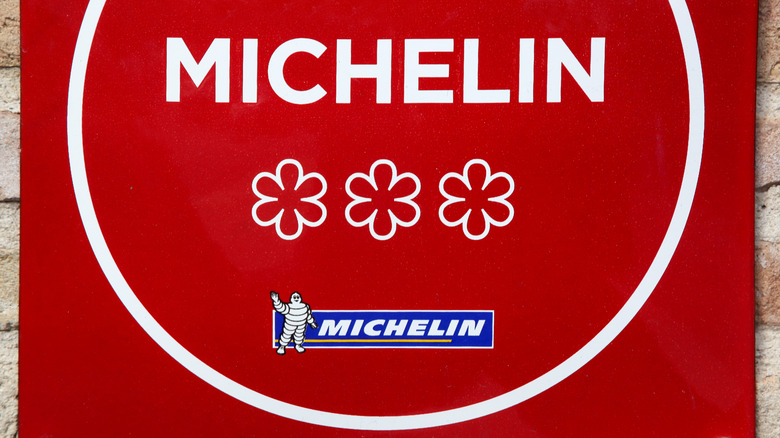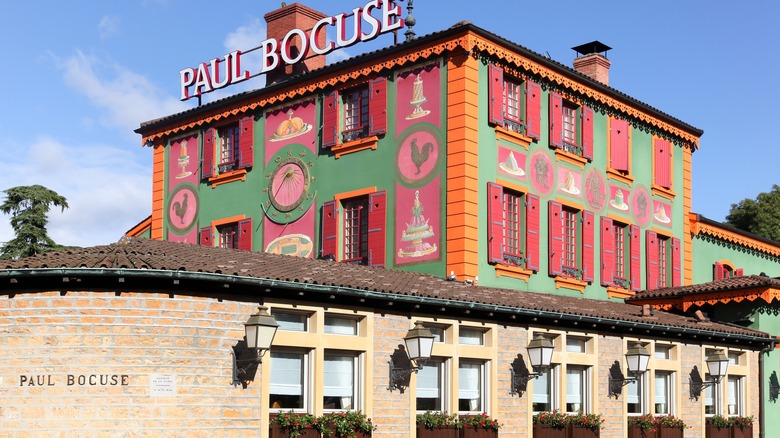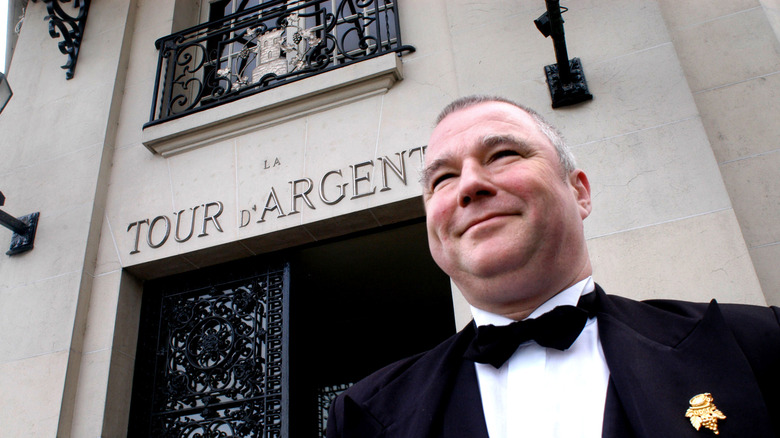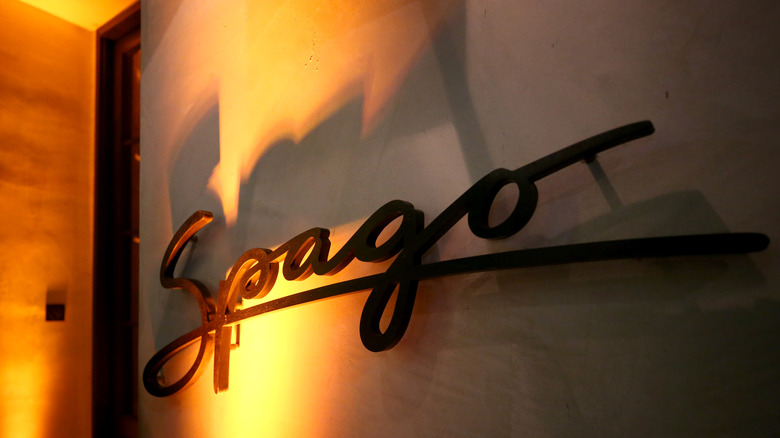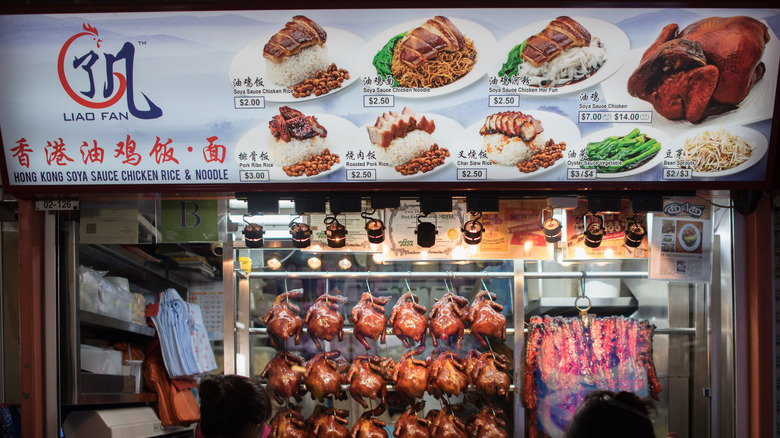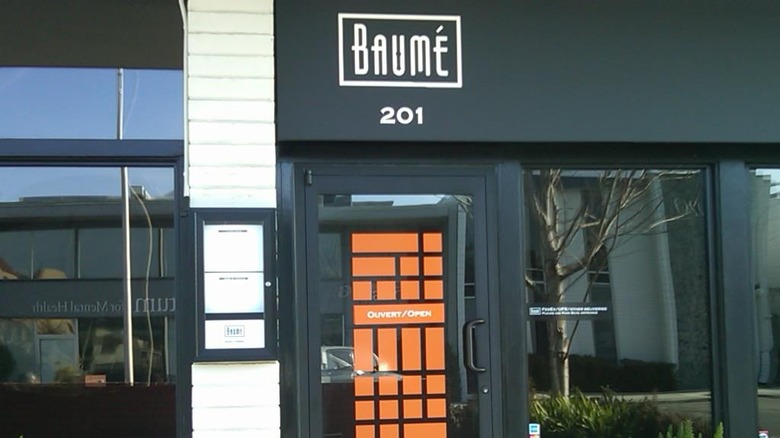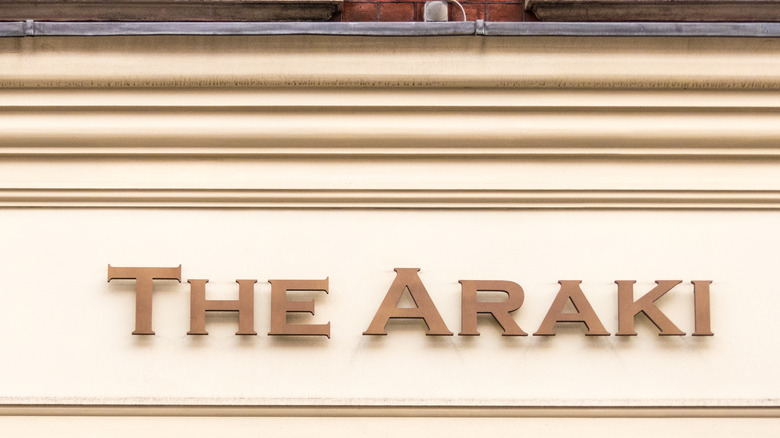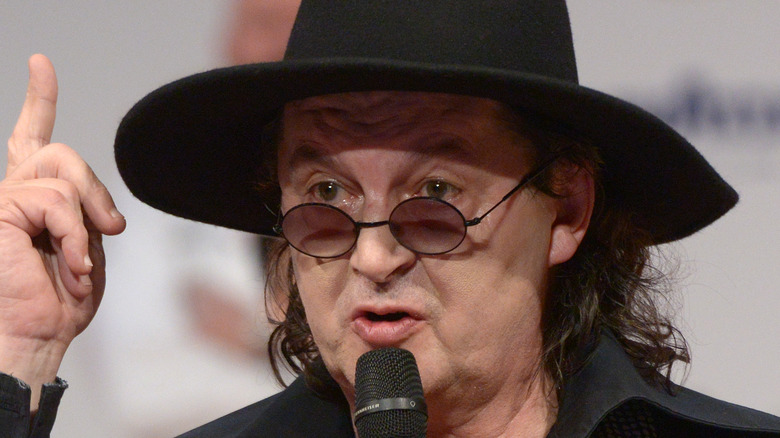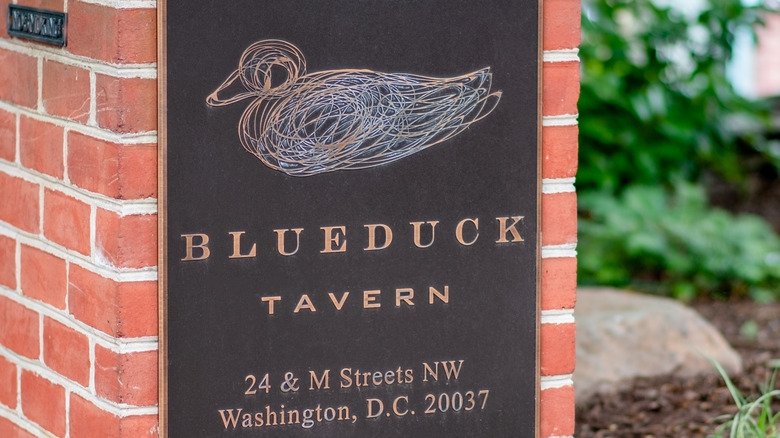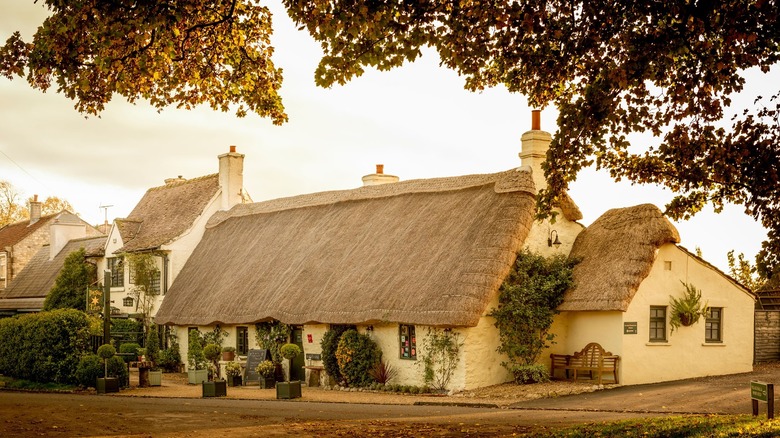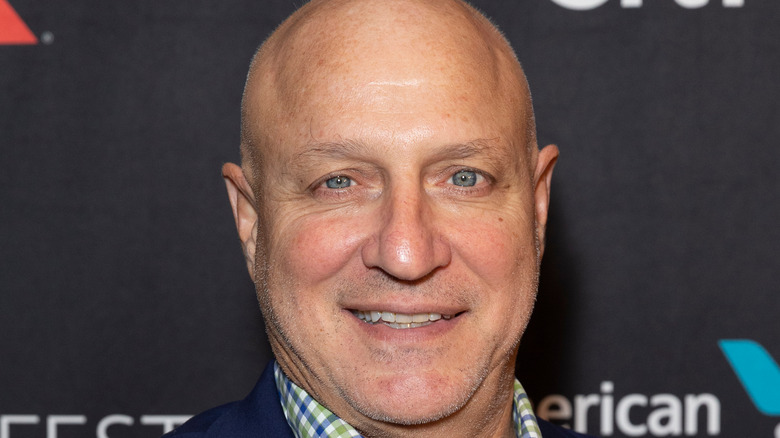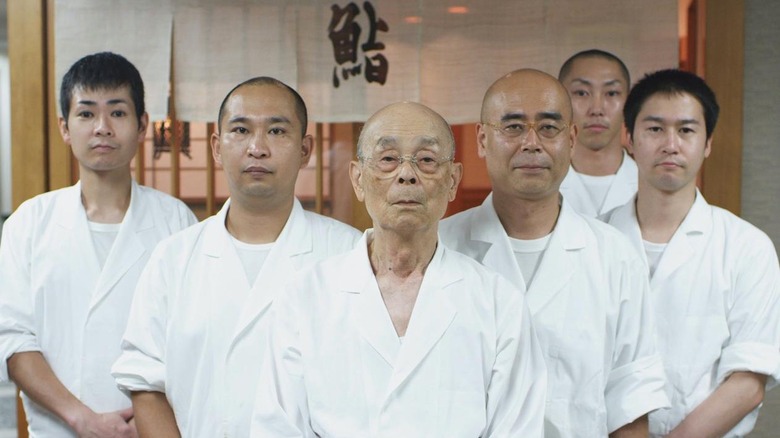14 Famous Restaurants That Lost Their Michelin Stars
The Michelin Guide is a series of books printed by the Michelin tire company of France. The guidebooks cover everything a motorist or road tripper might want to know when traveling in a certain region of the world, from where to locate hotels and auto shops to prominent local attractions. Since the Red Guide's first release in 1900, the most prominent aspect has been the restaurant selections. It's important to know that a Michelin star is awarded to a particular establishment and not the person or chef in charge. That said, the quest to get a Michelin star can be an intense one. Dining establishments can have their fates lifted by attaining the prestigious status of a Michelin star restaurant. Two is even better, while three stars are legendary.
Similarly, losing stars can have disastrous effects. Over the centuries-old course of grading restaurants, Michelin judges, known as Inspectors, have given and taken away countless stars. (Little is known about the exact formula that Inspectors use for their ratings.) Yet, it's commonly accepted that stars are doled out and removed based on food quality and consistency, as well as overall service and experience. Michelin hasn't wavered in removing their accolades where they see fit. Below are some examples of notable restaurants that have suffered the fate of losing their coveted Michelin stars.
Gordon Ramsay at The London
After studying under cooking giants like Marco Pierre White, Gordon Ramsay's first two stars were awarded in 1993 at the restaurant Aubergine. Next came the highest honor of three stars in 1998, doled out to Restaurant Gordon Ramsay, the chef's first independent venture. Ramsay-run restaurant Pétrus received a star in 1999, as did another self-named eatery in 2001.
Ramsay's first American restaurant, Gordon Ramsay at the London, opened in 2006. Per Eater, it debuted in the 2008 NYC Michelin Guide with much esteem from the inspectors, who appointed it two stars. Only a year later, Ramsay sold the restaurant but maintained a licensing agreement to use his name. In 2013, Michelin inspectors insinuated that Ramsay took the quality of the eatery with him when he left. The Guardian reported that meals were described as "erratic" and lacking in consistency, costing the restaurant it's two Michelin stars.
Ramsay admitted to weeping at the historic loss — reportedly, this was the first time in Michelin Guide history where quality caused a restaurant to drop from two stars to nil. According to Grub Street, The London ultimately closed its doors in 2014.
L'Auberge du Pont de Collonges
To say that Chef Paul Bocuse lived and died by excellent food is about as literal a statement as can be made about the French titan. In 1926, Bucose was born in a room above his family's failing hotel-eatery. As reported by the BBC, in 2018 Bucose died in the same room, although the building was now his renowned restaurant L'Auberge du Pont de Collonges (aka Bocuse). Between those years, Paul Bocuse rose to become known as "the Pope of French Cooking," with his talents blessing three Michelin stars to the restaurant bearing his name. But in 2020, just two years after his death, the Michelin Guide ended his historic streak.
L'Auberge du Pont de Collonges grew into a pillar of French dining thanks to a new technique known as nouvelle cuisine, which went against the rich, grand flavors of traditional French food (per Gayot). Auberge du Pont de Collonges offered a fresher, lighter take on the tastes of the region, resulting in a prestigious three star ranking from Michelin in 1965. When Bocuse was marked down from three stars to two in 2020, it ended a 55-year run. That streak had previously given Bocuse the title of "World's Oldest Three Star Restaurant."
The downgrade wasn't without controversy. Prominent French chef Marc Veyrat called the move "pathetic." Michelin inspectors said that the food was simply, "no longer at the level of three stars."
Le Suquet
For some, the Michelin Guide is a sign of high prestige. For others, however, Michelin stars are seen as a curse. Critics say the system is flawed, that Michelin favors and prioritizes a certain type of restaurant. (Chiefly, upscale French cuisine.) Some who attain Michelin-level success describe the system's pressure as a "cruel test," while others (hello again, Marc Veyrat) describe Michelin inspectors as "incompetent" (per CNN). The chefs at three star Le Suquet count themselves among Michelin detractors.
Le Suquet is a rural restaurant in the south of France, originally opened and helmed by chef Michel Bras. Eater details how for decades, Le Suquet has been a pioneering location of haute cuisine, which is a foundational building block of modern day fine dining. Bras and team received the illustrious three-star status in 1999.
Michel Bras' son Sébastien Bras took over as chef of Le Suquet in 2009. Bras the younger continued to direct the family restaurant down the Michelin path before detouring in 2017. Citing "huge pressure" of maintaining three-star status to RFI, Bras asked Michelin to be left out of the guide, essentially revoking Le Suquet's stars. The request was obliged and Le Suquet did not appear in the 2018 Guide. However, Michelin inspectors just couldn't seem to get enough of the fresh French food. In 2019, Le Suquet returned to the Red Guide with two stars.
The Restaurant Marco Pierre White
While Le Suquet may have been the first French restaurant to revoke it's Michelin stars, it was not the first location in history to voluntarily give up the prestigious status. Many chefs and restaurants have "handed back" their stars by closing up shop or changing the concept of their restaurant. One such case was Restaurant Marco Pierre White.
The Telegraph reports that Restaurant Marco Pierre White opened in the Hyde Park Hotel in London in September 1993. After previously winning two Michelin stars at Harveys, Chef Marco Pierre White opened his namesake restaurant specifically in pursuit of a third star. White's outstanding French cuisine exploded in popularity, bringing three stars to Restaurant Marco Pierre White in 1995. The Guardian notes that at 33, the chef was the youngest person to ever receive this honor.
At this point, Pierre was said to have become further driven with the Michelin process (via The New Yorker). He moved the restaurant into a larger location in the Oak Room at Le Méridien Piccadilly Hotel. The goal was set to achieve a higher "five red forks and knives" rating from Michelin. The Restaurant received this "Best in Class" designation in 1998, prompting White to retire in 1999. When he did, each Michelin accolade was returned. Starting from zero, The Restaurant Marco Pierre White received one star in 2001 and again in 2002 under new chef Robert Reid before it closed a year later.
Tour d'Argent
The Michelin Guide has been a pillar of French cuisine since the initial star ratings began in 1936. Since then, of all the restaurants that have held stars, only a select few have a longer history than the book itself. One of those historic establishments is Tour d'Argent, located in Paris, France. At the 439-year old restaurant, Michelin stars have come and gone along with celebrities and royalty.
Tour d'Argent sits on the kind of vantage point that could only be exclusive. Overlooking the idyllic river Seine and Notre Dame Cathedral, the mythos around this eatery has grown over centuries. Ernest Hemingway and Marcel Proust both wrote about the Tour d'Argent. Henri IV was rumored to dine there. La Tour d'Argent even claims to be where the fork was first introduced to France. La Tour attained three Michelin stars in the initial 1930s guidebook. The age-old eatery would hold onto that honor for most of the 20th century, up until 1996.
From there, things have gone downhill where it comes to the Guide. Despite the owner of Tour d'Argent assuring they would "get that star back," Michelin inspectors have only since downgraded it. Tour d'Argent has been a one star restaurant since 2016.
Spago
California cuisine is a segment of American food that began taking shape in the 1970s before quickly becoming a cultural force. The cuisine's emphasis on fresh, locally available ingredients has defined the farm-to-table movement and brought sustainability past trendiness and into being a core value for diners. Along with the French Laundry, Wolfgang Puck's Spago was at the forefront of this eating movement.
Spago forever changed American cuisine when it opened on the Sunset Strip in 1982. As Puck's first independent endeavor, Spago was a statement about our country's food and social heritage: fresh and seasonal ingredients, cooked in a melting pot of international cooking techniques. The signature California nouvelle spread across Los Angeles and America so fast that by 1997 Spago was opening big digs in Beverly Hills. It was here that the restaurant received its two star Michelin rating when the Guide made its first-ever visit to Los Angeles in 2008.
Spago continued to hold steady at two stars when Michelin returned in 2009. After stirring up the LA food scene, Michelin abandoned the city from 2010 to 2019. Inspectors even went so far as to slander LA diners as "not real foodies" (via The New Yorker). When the guidebook returned in 2019, Spago lost its Michelin stars. Apparently Gordon Ramsay is not the only celebrity chef to lose two Michelin stars at one moment.
Hawker Chan
"Cheap" is not often a word that gets associated with Michelin-starred restaurants, but the Singaporean Hawker Chan is just that. When Chef Chan Hon Meng's food stall received it's first star in 2016, it also came with the accolade of being Michelin's cheapest meal at a price of $2.25 USD for the stall's signature offering (per CNN). The soya chicken and rice plate which is served at Hawker Chan often generates two hour lines outside the small serving window, as reported by Insider. The food stall might lack the upscale ambience that typifies a Michelin star, but it makes up for it in exclusivity: Just 200 portions are cooked and served daily.
After receiving a star in 2016, Meng's international brand skyrocketed. Hawker Chan has been franchised in Thailand and the Philippines while riding on the wave of Michelin triumph. However, when the guidebook returned to Singapore in 2021 it did not include Hawker Chan (via Food and Wine). The Michelin Guide has yet to comment about the reasons the restaurant lost out on its single star.
Baumé
From the smallest priced Michelin star meal to the Guide's smallest staffed restaurant. Baumé has been at the forefront of French cuisine in the Bay Area since opening in 2010. The cutting-edge establishment received one star within it's first year of operation and a second star fell in 2011. Since the restaurant is run solely by the husband and wife duo of Bruno and Christie Chemel, Baumé also picked up the tagline of being "the only two star restaurant with two staff members."
After carrying two stars since 2011, as of September 2021 this Palo Alto business is one of many small eateries with only two staff members and no Michelin stars. Similar to Wolfgang Puck's Spago, Baumé took a hit from two star to none (per San Francisco Chronicle). Chef Bruno Chemel claims that Michelin removed the restaurant from the guide on his request, although the official reasons remain unclear. In 2020, Baumé pivoted to offering four-course takeout meals before resuming a very limited dinner seating in March of 2021. It remains to be seen whether the stars will return when more customers do.
The Araki
Along the Michelin Guide's history, there have been some serious star losses. Even with all these drastic downgrades and dramatic forfeitures of stars, the story of The Araki is still one of the most severe tales of how far some can fall from Michelin star status.
The Araki London was founded in 2014 by Japanese chef Mitsuhiro Araki. This sushi restaurant, located in London's Mayfair, was one in a series of successes for the well known chef, as (per CNN). Prior to the UK location, Araki ran another eponymous restaurant in Tokyo which had been awarded three stars thanks to an adherence to traditional Japanese culture and food. The Araki London received two stars in 2016 before picking up another one in 2018, becoming the UK's first Japanese restaurant to attain a three star profile (per The Independent).
The Araki in London has only nine seats, not including the one the chef fills. When Mitsuhiro Araki announced that he would be vacating his position as head of The Araki, Michelin packed up the restaurant's three stars as well. Although Araki was replaced by his protégé of many years, Michelin decided that the restaurant would start from scratch, a decision which sparked debate. As Eater London reports, Michelin Inspectors are tasked with judging a restaurant strictly by quantifiable criteria like food, service, atmosphere and experience — not who wears the chef hat.
La Maison des Bois
High in the French Alps is an eatery that The Telegraph once described as sitting in "splendid solitude." La Maison des Bois is the signature location of Marc Veyrat, whose sophisticated cooking has pushed French mountain food to a new level. Referred to by fine dining blog Luxeat as a temple to the wild and foraged foods of the region, La Maison des Bois received a three star rating from the Michelin Guide in 2018 (per the Telegraph). Ironically enough it was the loss of a star that may have most popularized this restaurant.
Michelin Inspectors in 2019 downgraded La Maison des Bois from three stars to two. What caused the change? Per Eater, Inspectors claimed that Veyrat put cheddar cheese into a soufflé, a cardinal sin of French cuisine. In response to this slight, Michelin Veyrat took action. The BBC reports Veyrat asked that La Maison des Bois be removed from the guide altogether. Michelin refused, so Veyrat took the company to court. In his suit, Veyrat questioned the competency of Michelin Inspectors and challenged if they had visited his restaurant at all. Seeking clarification on the loss of a star, Veyrat sued for a single euro's worth of damages.
After deliberation, French courts decided that Veyrat's claims of "disgrace" were not enough to fault the guidebook and Michelin won the case. The outcome for La Maison des Bois and Chef Veyrat? Still two stars, and over $30,000 owed in damages to Michelin's reputation.
Blue Duck Tavern
With all the drama surrounding high profile restaurants winning and losing Michelin stars, it can be easy to forget that there are loads of spots that loose their stars without much ceremony (or lawsuits). Blue Duck Tavern is one case of a popular restaurant quietly going through the hot and cold perception of Michelin Inspectors.
As the nation's capital of government, Washington D.C. is subject to a wide array of influences. That holds true for politics and the District's food scene, which has long thrived off of the regional food system that is America's eastern seaboard. Blue Duck Tavern opened at the Park Hyatt in 2006, offering flavors and ingredients of the Chesapeake watershed. Immediately, Blue Duck began shaping the national farm-to-table dining trend (per Forbes Travel Guide).
Michelin's first D.C. Guide came ten years after Blue Duck's emergence on the "Farm-sourcing" scene. The 2016 Red Book brought one star to the Tavern. It remained at that listing until 2020 when Michelin fairly quietly removed it altogether as reported by the Georgetown Owner.
The Star Inn at Harome
The pub may be a cornerstone of the food culture in the UK, but the French-origin Michelin Guide has not always seen it as a type of restaurant worthy of inclusion in its hollowed pages. The Michelin Guide has been printed for Great Britain since 1972, yet it wasn't until 2001 that the first proper pub made its appearance. The next year, the Star Inn at Harome became only the second pub to do so, receiving one Michelin star. You might say that chefs Andrew and Jacquie Pern named the restaurant after their goal.
With Michelin status, The Star Inn at Harome became a national and international leader in the evolution of the gastropub. The style of restaurant took off and Michelin took notice. The Starr Inn held its level one ranking from 2002 until 2010 before being left out of the 2011 Guide. However by this time, Michelin had now included 10 pubs in their guide. Not to be left out of the trend it created, Big Hospitality reported The Starr Inn at Harome regained their one star in 2015.
Craft
The early 2000's were a big, fast time for the Michelin Guide in America. Really, the early 2000's were a fast time for American food culture entirely. One of the hottest aspects of culinary development during this era was the Food Network and the rise of the celebrity chef. As programs like "MasterChef" and "Iron Chef" played on TVs across the country, cooks everywhere got to work trying to build their personal brands. Some chefs, like Tom Colicchio, even spun their success into gold stars.
As Daily Beast reports, New York's Craft opened in 2001, just months before September 11th. The head chef at the time was Tom Colicchio, former partner to restaurateur Danny Meyer, protégé of Thomas Keller, and future head judge of "Top Chef" (per Eater NY). Craft's arrival in New York brought pared-down flavors to the East Coast: fresh seafood and meats with minimal sauces, seasoned with herbs, and served in a simple setting. As the Daily Beast writes, Craft's cuisine was "comfort cooking" that "allowed for a form of collective healing ... the right restaurant at the right time."
Michelin first visited New York City in 2005 and they shared the sentiment about Craft, awarding it a single star. However the rating was lost by the time the 2007 Michelin Guide was released (per Reuters).
Sukiyabashi Jiro
When the Michelin Guide entered Tokyo in 2007, it rained more stars down on the city than any other across the world. That year, Tokyo had even more three star restaurants than Paris. One of those locations that got top honors was Sukiyabashi Jiro.
Sukiyabashi Jiro has long been known by devotees as the best sushi restaurant in the world (via Travel and Leisure). It is now also regarded as one (if not the most) exclusive restaurant out there. (Chef Jiro Ono and his restaurant were the subject of the 2011 documentary sensation "Jiro Dreams of Sushi.") 10-seat sushi bar has fed presidents, prime ministers, and Michelin Inspectors alike. Although, lately the latter party has had a tough time getting in the door. In 2019, Sukiyabashi Jiro closed reservations to the general public. Unable to get a seat before the 92-year old Ono, the Michelin Guide stripped Sukiyabashi Jiro of its stars. After going from three Michelin stars to zero on account of having too much good business, Jiro probably has a lot of other things to dream of now.
